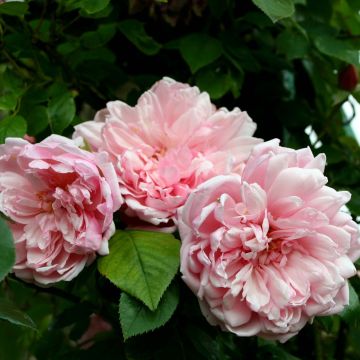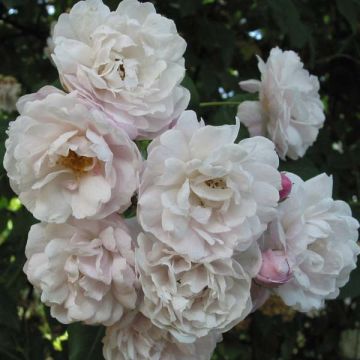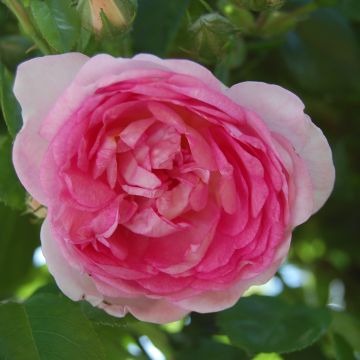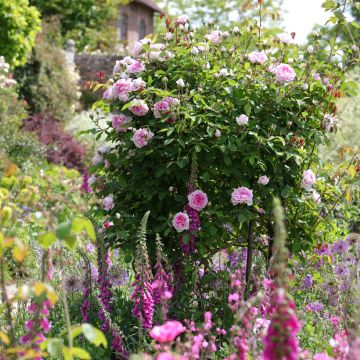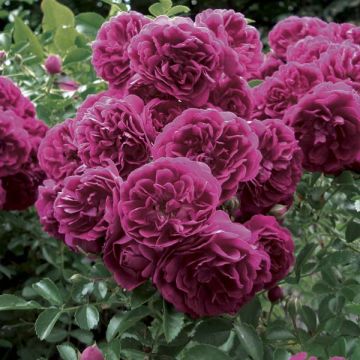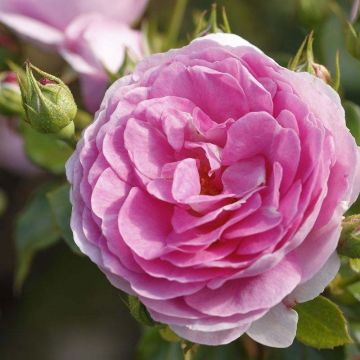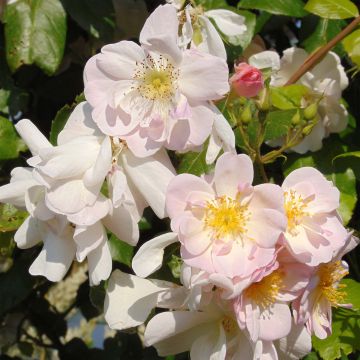Shipping country and language
Your country of residence may be:
Your country of residence is:
For a better user experience on our website, you can select:
Your shipping country:
-
Andorra
-
Austria
-
Belgium
-
Bulgaria
-
Canada
-
Chile
-
Croatia
-
Cyprus
-
Czechia
-
Denmark
-
Estonia
-
Finland
-
France
-
Germany
-
Greece
-
Hungary
-
Iceland
-
Ireland
-
Italy
-
Latvia
-
Lithuania
-
Luxembourg
-
Malta
-
Monaco
-
Netherlands
-
Poland
-
Portugal
-
Romania
-
Slovakia
-
Slovenia
-
Spain
-
Sweden
-
Switzerland
-
United Kingdom
We only deliver seed and bulb products to your country. If you add other products to your basket, they cannot be shipped.
Language:
-
French
-
German
-
Spanish
-
English
-
Italian
My Account
Hello
My wish lists
Log in / Register
Existing customer?
New customer?
Create an account to track your orders, access our customer service and, if you wish, make the most of our upcoming offers.


Rosier grimpant Long Island Oralinco


Rosier grimpant Long Island Oralinco
Rosa 'Long Island' - Climbing Rose
Rosa Long Island Oralinco
Oralinco
Why not try an alternative variety in stock?
View all →Order in the next for dispatch today!
Dispatch by letter from €3.90.
Delivery charge from €5.90 Oversize package delivery charge from €6.90.
More information
This item is not available in your country.
Schedule delivery date,
and select date in basket
This plant carries a 6 months recovery warranty
More information
We guarantee the quality of our plants for a full growing cycle, and will replace at our expense any plant that fails to recover under normal climatic and planting conditions.
From €5.90 for pickup delivery and €6.90 for home delivery
Express home delivery from €8.90.
From €5.90 for pickup delivery and €6.90 for home delivery
Express home delivery from €8.90.
Does this plant fit my garden?
Set up your Plantfit profile →
Description
The 'Long Island' climbing rose is a variety that is not very tall but vigorous, very floriferous from June to October and full of charm. This rose has good natural disease resistance and charming, old-fashioned roses in a porcelain pink colour, highly fragrant. They tirelessly bloom in glorious clusters, perfectly complemented by their large, beautiful dark green leaves that remain attractive throughout the season. This small climbing rose is a vibrant plant, very easy to care for, versatile, and can also be trained as a large bush according to each gardener's preference.
The Long Island Oralinco rose is an excellent creation by the rosarian Orard, introduced in 2022. This horticultural hybrid belongs to the floribunda rose family, with flowers arranged in clusters. Its growth is fast, developing long, climbing, upright stems that are green and more or less covered with sharp thorns, flexible enough to be trained. When trained as a climber, this variety reaches an average height of 2.75 m (9ft) with a spread of 1 m (3ft). Its long stems are covered with glossy and tough foliage, divided into dentate leaflets in a dark green colour. The 'Long Island' roses, 8 cm (3in) wide, have 120 petals. They take the form of fairly deep, very double cups in quarters and are grouped in small clusters of 3 to 5 buds. The flowering period extends from May-June to October. Their colour is pure pink, warmer in the centre. They exude an intense fragrance. The deciduous foliage falls in autumn.
'Long Island' is a charming rose planted for its robustness and floribundity. Like other climbing roses, it is incomparable for adorning a gate, fences, and small pergolas, but it can also be used as a bush by regularly pruning it to encourage branching and limit its height. This usage pairs well with white or mauve lilacs, buddleias, etc. Its pink flowering complements that of the 'Prince Charles' clematis, in blue, or Miss Bateman, in white. It is an ideal companion for dead trees that it will revive or sheds that give a charming appeal. Trained on an arch or planted on an unsightly fence, it adorns any setting, including the pa,tio without demanding much effort from the planter.
Report an error about the product description
Rosa 'Long Island' - Climbing Rose in pictures


Plant habit
Flowering
Foliage
Botanical data
Rosa
Long Island Oralinco
Rosaceae
Oralinco
Cultivar or hybrid
Other Climbing Roses
Planting and care
The 'Long Island' climbing rose prefers sunny locations but dreads hot and cramped exposures that can make it more susceptible to powdery mildew: avoid espaliering it against a south or west wall. While it does not appreciate excessive limestone, it tolerates it. It prefers deep, fertile and rather moist soils that allow it to reach its full potential.
It will adapt to any garden as long as the soil is well worked and rich enough. To plant your rose, work the soil by crumbling it well and put an amendment at the bottom of the planting hole, such as blood, fish and bone. Water generously after planting to remove air pockets. Water regularly for a few weeks to facilitate rooting and the first two dry and hot summers. Pruning is only necessary to limit its growth. If its spread bothers you, don't hesitate to reduce the branches.
Planting period
Intended location
Care
This item has not been reviewed yet - be the first to leave a review about it.
Roses by purpose
Haven't found what you were looking for?
Hardiness is the lowest winter temperature a plant can endure without suffering serious damage or even dying. However, hardiness is affected by location (a sheltered area, such as a patio), protection (winter cover) and soil type (hardiness is improved by well-drained soil).

Photo Sharing Terms & Conditions
In order to encourage gardeners to interact and share their experiences, Promesse de fleurs offers various media enabling content to be uploaded onto its Site - in particular via the ‘Photo sharing’ module.
The User agrees to refrain from:
- Posting any content that is illegal, prejudicial, insulting, racist, inciteful to hatred, revisionist, contrary to public decency, that infringes on privacy or on the privacy rights of third parties, in particular the publicity rights of persons and goods, intellectual property rights, or the right to privacy.
- Submitting content on behalf of a third party;
- Impersonate the identity of a third party and/or publish any personal information about a third party;
In general, the User undertakes to refrain from any unethical behaviour.
All Content (in particular text, comments, files, images, photos, videos, creative works, etc.), which may be subject to property or intellectual property rights, image or other private rights, shall remain the property of the User, subject to the limited rights granted by the terms of the licence granted by Promesse de fleurs as stated below. Users are at liberty to publish or not to publish such Content on the Site, notably via the ‘Photo Sharing’ facility, and accept that this Content shall be made public and freely accessible, notably on the Internet.
Users further acknowledge, undertake to have ,and guarantee that they hold all necessary rights and permissions to publish such material on the Site, in particular with regard to the legislation in force pertaining to any privacy, property, intellectual property, image, or contractual rights, or rights of any other nature. By publishing such Content on the Site, Users acknowledge accepting full liability as publishers of the Content within the meaning of the law, and grant Promesse de fleurs, free of charge, an inclusive, worldwide licence for the said Content for the entire duration of its publication, including all reproduction, representation, up/downloading, displaying, performing, transmission, and storage rights.
Users also grant permission for their name to be linked to the Content and accept that this link may not always be made available.
By engaging in posting material, Users consent to their Content becoming automatically accessible on the Internet, in particular on other sites and/or blogs and/or web pages of the Promesse de fleurs site, including in particular social pages and the Promesse de fleurs catalogue.
Users may secure the removal of entrusted content free of charge by issuing a simple request via our contact form.
The flowering period indicated on our website applies to countries and regions located in USDA zone 8 (France, the United Kingdom, Ireland, the Netherlands, etc.)
It will vary according to where you live:
- In zones 9 to 10 (Italy, Spain, Greece, etc.), flowering will occur about 2 to 4 weeks earlier.
- In zones 6 to 7 (Germany, Poland, Slovenia, and lower mountainous regions), flowering will be delayed by 2 to 3 weeks.
- In zone 5 (Central Europe, Scandinavia), blooming will be delayed by 3 to 5 weeks.
In temperate climates, pruning of spring-flowering shrubs (forsythia, spireas, etc.) should be done just after flowering.
Pruning of summer-flowering shrubs (Indian Lilac, Perovskia, etc.) can be done in winter or spring.
In cold regions as well as with frost-sensitive plants, avoid pruning too early when severe frosts may still occur.
The planting period indicated on our website applies to countries and regions located in USDA zone 8 (France, United Kingdom, Ireland, Netherlands).
It will vary according to where you live:
- In Mediterranean zones (Marseille, Madrid, Milan, etc.), autumn and winter are the best planting periods.
- In continental zones (Strasbourg, Munich, Vienna, etc.), delay planting by 2 to 3 weeks in spring and bring it forward by 2 to 4 weeks in autumn.
- In mountainous regions (the Alps, Pyrenees, Carpathians, etc.), it is best to plant in late spring (May-June) or late summer (August-September).
The harvesting period indicated on our website applies to countries and regions in USDA zone 8 (France, England, Ireland, the Netherlands).
In colder areas (Scandinavia, Poland, Austria...) fruit and vegetable harvests are likely to be delayed by 3-4 weeks.
In warmer areas (Italy, Spain, Greece, etc.), harvesting will probably take place earlier, depending on weather conditions.
The sowing periods indicated on our website apply to countries and regions within USDA Zone 8 (France, UK, Ireland, Netherlands).
In colder areas (Scandinavia, Poland, Austria...), delay any outdoor sowing by 3-4 weeks, or sow under glass.
In warmer climes (Italy, Spain, Greece, etc.), bring outdoor sowing forward by a few weeks.

